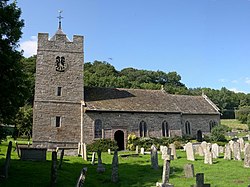Whitney-on-Wye

Whitney-on-Wye is a village and parish in the Huntington Hundred of Herefordshire, close to the border with Radnorshire. The population of this civil parish at the 2011 census was 117.[1] It is on the A438 road, and on the River Wye. The village is 15 miles west of Hereford. The church is dedicated to the Saints Peter and Paul.[2]
History
Whitney-on-Wye was first mentioned in the Domesday Book with the spelling Witenie. The most plausible meaning for the name is White Water, from the Anglo-Saxon hwit (white) and ey (water), and probably refers to the River Wye which runs through the area and which can become a torrent when heavy rains in the Welsh mountains cause it to swell.
During the Captain Swing riot movement of 1830, Whitney was a site in Herefordshire for protest by the dispossessed farm labourers who threatened arson and machine breaking to try to obtain a living wage. On 17 November 1830, Henry Williams, a 'ranting' preacher and journeyman tailor wrote a threatening letter to a large farmer citing the fires that had been set in the barns of those who had ignored the poor in the county of Kent. For his pains he was sentenced to transportation to New South Wales.[3]
See also
References
- ↑ "Civil Parish population 2011". http://www.neighbourhood.statistics.gov.uk/dissemination/LeadKeyFigures.do?a=7&b=11130584&c=HR3+6EG&d=16&e=62&g=6385824&i=1001x1003x1032x1004&m=0&r=0&s=1446119924641&enc=1. Retrieved 29 October 2015.
- ↑ Eardisley Church Heritage - Whitney-on-Wye
- ↑ Eric Hobsbawm and George Rudé 1968 Captain Swing, Toronto: Norton and Co.
Outside links
| ("Wikimedia Commons" has material about Whitney-on-Wye) |
- Location map: 52°7’16"N, 3°4’1"W

This Herefordshire article is a stub: help to improve Wikishire by building it up.
